
Fragrant Mimosa: The Most Beautiful Varieties for a Blooming and Scented Garden
Selection of mimosas as beautiful as they are fragrant, perfect for the garden or in pots
Contents
You’re surely familiar with the beautiful yellow pompon flowering of the mimosa, which poetically heralds the end of winter. But some of them don’t just bring us a touch of light: they also turn out to be wonderfully fragrant, perfuming the air especially on sunny days. They exude floral and almost herbaceous notes, with a powdery, honeyed touch.
These bushes will allow you to create a sensory garden or simply brighten up a terrace or balcony. Discover our selection of must-have fragrant mimosas.
As a complement, to learn all about growing mimosas, check out our feature Mimosa: planting, pruning and care.
The florist's mimosa or Acacia dealbata
This is one of the most widespread mimosas, and you can easily find beautiful bouquets at florists towards the end of winter. The Acacia dealbata is also known as winter mimosa, referring to its flowering period between January and March. It reveals then generous clusters of small yellow pompom flowers, which are highly fragrant. Their scent is initially herbaceous and very fresh, then develops gourmet honeyed notes over time, becoming more powdery.
The foliage is also noteworthy. Evergreen, it remains decorative all year round and adds an exotic touch, thanks to its finely divided structure, reminiscent of fern fronds. It is glossy dark green with bluish to silvery reflections.
The florist’s mimosa is native to Australia. It is a large bush or small tree, reaching about 5 metres in all directions. Its hardiness can reach -9°C, though this may be more limited for grafted specimens (around -6°C). In return, grafting improves its tolerance to lime, allowing it to be grown in more regions.
It is therefore a bush suited to mild climates, but it can also be grown in a large pot to protect it from severe winter frosts. On the French Riviera, it particularly thrives in hot, dry conditions, coupled with well-drained, slightly acidic soil. There, it is even considered invasive, as it competes with local species. The commercially available varieties are generally less prone to suckering, reducing the risks.
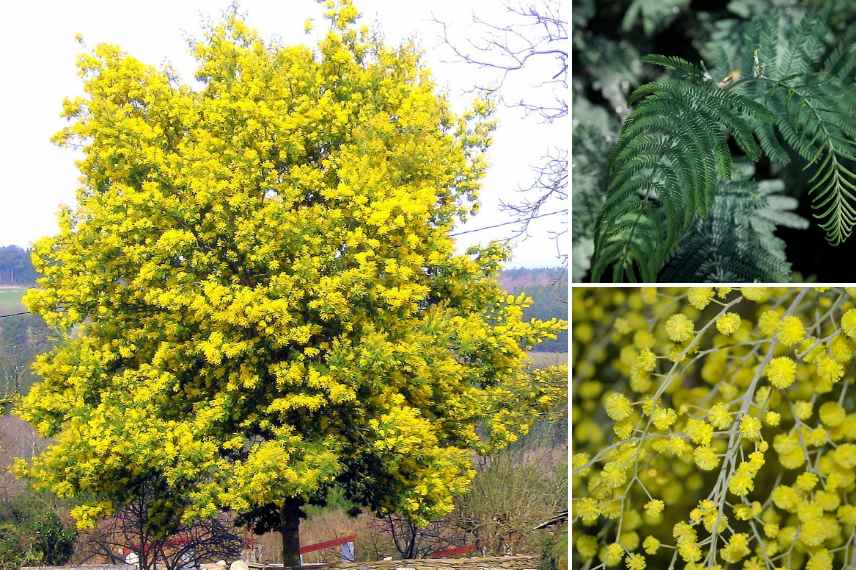
Acacia dealbata
Read also
To grow mimosa in a potThe four seasons mimosa or Acacia retinodes
The four seasons wattle has the unique characteristic of flowering for a very long time, as it blooms several times a year. You can enjoy it from mid-spring right up to the onset of winter. The rest of the time, its flowering will be more irregular. Unlike its cousin, the florist’s mimosa, this is more of a summer mimosa.
Acacia retinodes treats us to a generous display of yellow pom-pom flowers, which diffuse a unique and instantly recognisable fragrance. It is highly prized in floral art.
Its evergreen foliage consists of flattened, ovate and very elongated petioles in a bright green hue.
The bush has a graceful habit, reaching about 4 metres in all directions.
Due to its Australian origins, however, it is not very hardy: it should not be exposed to frosts below -6°C. On the other hand, it has the advantage of tolerating lime well. This is why it is used as a graft for other varieties. It will also show tolerance to drought. Finally, it has the benefit of not producing suckers.
This fragrant mimosa can be grown in the ground in regions with a mild climate, and in large pots or containers elsewhere, to be moved to a frost-free room when the first cold weather arrives.
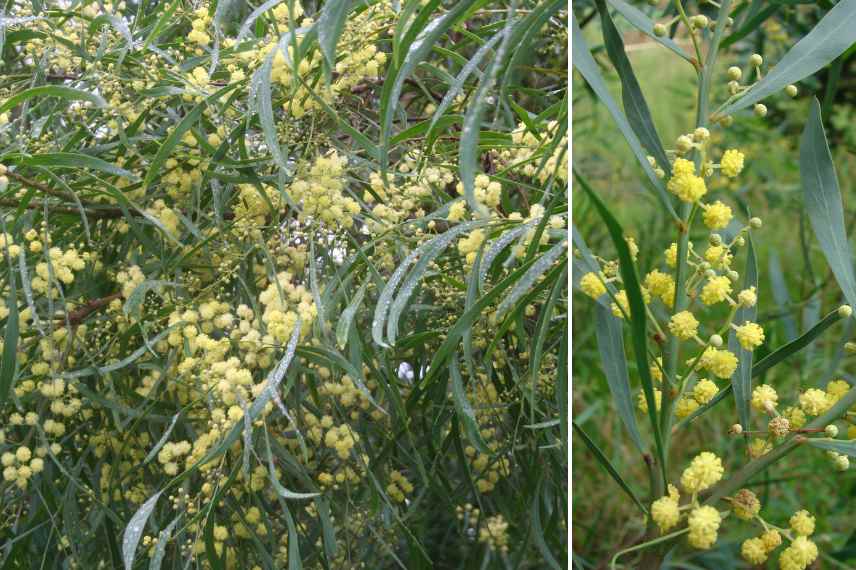
Acacia retinoides
The sticky wattle ‘Clair De Lune’ or Acacia howittii
The Acacia howittii ‘Clair de Lune’ is a horticultural cultivar (resulting from human-led hybridisation). It stands out for its gracefully weeping and highly ornamental habit, reaching approximately 4 metres in height with a 3-metre spread.
This wattle flowers in early spring, between March and April. It then reveals the characteristic fluffy pom-pom clusters typical of the genus, though with a lemon-yellow hue. Generous and fragrant, this flowering period delights the garden and awakens the senses.
Its foliage consists of linear phyllodes (petioles modified into leaf-like structures) that first display a stunning purplish-red during the bud burst period before turning light green. The leaves remain evergreen throughout the year, even in winter.
Once again, this variety is best suited to mild climates for outdoor cultivation but will adapt well to container growing elsewhere. Its hardiness is indeed limited to -6°C.
In full sun or partial shade, in well-drained, even dry soil, this wattle will be ideal for adding a sunny, fragrant touch.
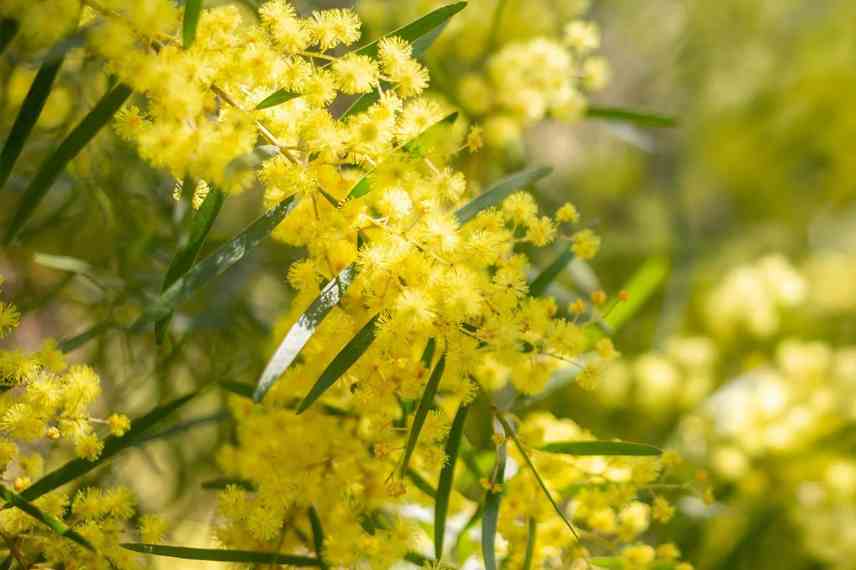
Acacia howittii ‘Clair de Lune’
Read also
How to protect wattle over winter?The willow-leaved wattle or Acacia iteaphylla
The willow-leaved wattle is an ideal candidate for growing in confined spaces, as its silhouette does not exceed 2.5 metres in height with a 2-metre spread. Its habit is also quite compact. As for its foliage, it produces greyish-blue leaves that remain visible all year round.
Like its counterparts, this wattle treats us to beautiful clusters of soft lemon-yellow pompon flowers, visible from autumn until late winter, depending on the climate. In addition to brightening up the colder season, they will perfume the surroundings with their vanilla and jasmine-like fragrance for many weeks.
Being not very hardy, its cold resistance is limited to -5°C, with a maximum of -7°C.
Its cultivation requirements are the same as other wattles: a sunny or partially shaded position, in well-drained soil, even if poor and dry.
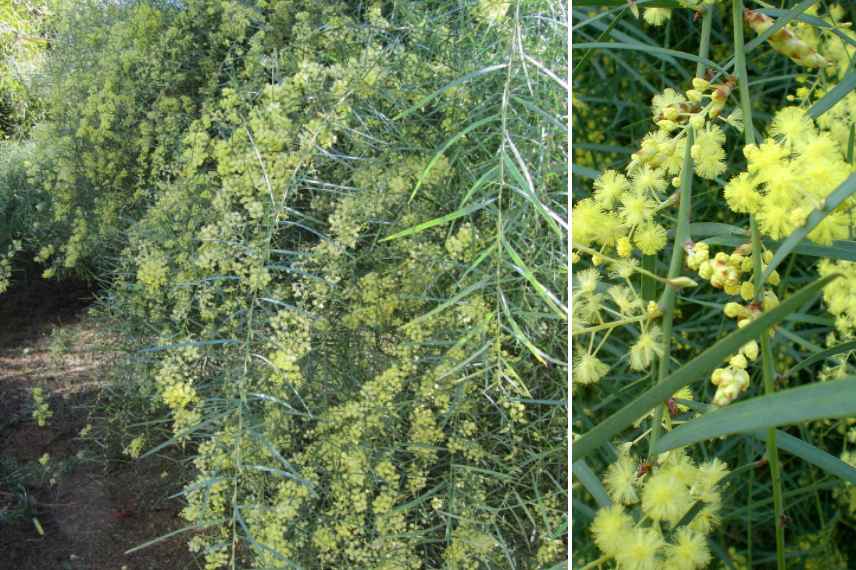
Acacia iteaphylla (© Leonora Enking)
The four seasons mimosa 'Lisette' or Acacia retinodes
‘Lisette’ is an interesting variety of four seasons wattle, prized for its generosity. More floriferous than the species type, it delights us with its clusters of highly fragrant yellow flowers, which appear several times throughout the year. They diffuse that famous green and herbaceous scent, which later develops powdery honey notes.
Otherwise, this variety shares the same characteristics as its parent. It has evergreen foliage, light and elongated, in a lovely bright green.
Not very hardy, ‘Lisette’ should be grown in pots in regions with harsh winters (temperatures below -6°C). In terms of cultivation, this fragrant wattle is tolerant of drought and limestone, while not producing suckers. Expect it to reach 4 metres in all directions at ripeness.
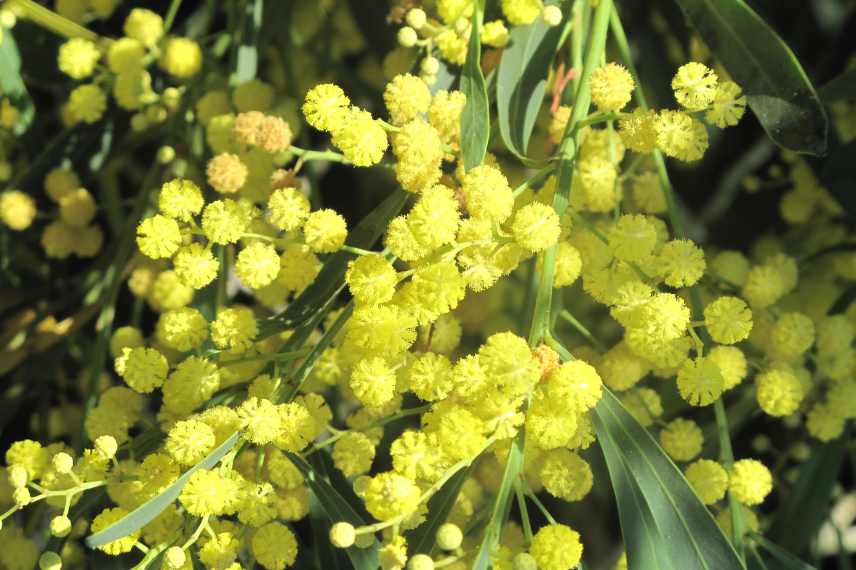
Acacia retinoides ‘Lisette’ (© Wikimedia Commons)
- Subscribe!
- Contents































Comments